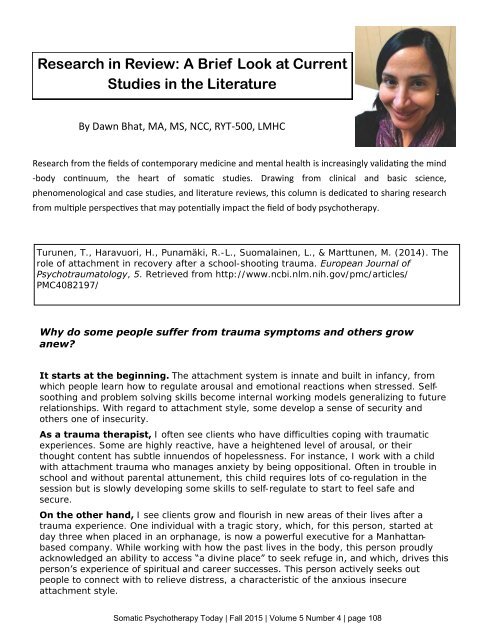Somatic Psychotherapy Today
1RCP3xp
1RCP3xp
Create successful ePaper yourself
Turn your PDF publications into a flip-book with our unique Google optimized e-Paper software.
Research in Review: A Brief Look at Current<br />
Studies in the Literature<br />
By Dawn Bhat, MA, MS, NCC, RYT-500, LMHC<br />
Research from the fields of contemporary medicine and mental health is increasingly validating the mind<br />
-body continuum, the heart of somatic studies. Drawing from clinical and basic science,<br />
phenomenological and case studies, and literature reviews, this column is dedicated to sharing research<br />
from multiple perspectives that may potentially impact the field of body psychotherapy.<br />
Turunen, T., Haravuori, H., Punamäki, R.-L., Suomalainen, L., & Marttunen, M. (2014). The<br />
role of attachment in recovery after a school-shooting trauma. European Journal of<br />
Psychotraumatology, 5. Retrieved from http://www.ncbi.nlm.nih.gov/pmc/articles/<br />
PMC4082197/<br />
Why do some people suffer from trauma symptoms and others grow<br />
anew?<br />
It starts at the beginning. The attachment system is innate and built in infancy, from<br />
which people learn how to regulate arousal and emotional reactions when stressed. Selfsoothing<br />
and problem solving skills become internal working models generalizing to future<br />
relationships. With regard to attachment style, some develop a sense of security and<br />
others one of insecurity.<br />
As a trauma therapist, I often see clients who have difficulties coping with traumatic<br />
experiences. Some are highly reactive, have a heightened level of arousal, or their<br />
thought content has subtle innuendos of hopelessness. For instance, I work with a child<br />
with attachment trauma who manages anxiety by being oppositional. Often in trouble in<br />
school and without parental attunement, this child requires lots of co-regulation in the<br />
session but is slowly developing some skills to self-regulate to start to feel safe and<br />
secure.<br />
On the other hand, I see clients grow and flourish in new areas of their lives after a<br />
trauma experience. One individual with a tragic story, which, for this person, started at<br />
day three when placed in an orphanage, is now a powerful executive for a Manhattanbased<br />
company. While working with how the past lives in the body, this person proudly<br />
acknowledged an ability to access “a divine place” to seek refuge in, and which, drives this<br />
person’s experience of spiritual and career successes. This person actively seeks out<br />
people to connect with to relieve distress, a characteristic of the anxious insecure<br />
attachment style.<br />
<strong>Somatic</strong> <strong>Psychotherapy</strong> <strong>Today</strong> | Fall 2015 | Volume 5 Number 4 | page 108


